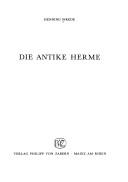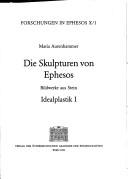| Listing 1 - 7 of 7 |
Sort by
|
Book
ISBN: 147505193X 9781475051933 Year: 2012 Publisher: [S.l.] : [CreateSpace] ;,
Abstract | Keywords | Export | Availability | Bookmark
 Loading...
Loading...Choose an application
- Reference Manager
- EndNote
- RefWorks (Direct export to RefWorks)
Hermae. --- Athens (Greece) --- Athens (Greece) --- Politics and government. --- History.

ISBN: 3805308663 Year: 1986 Publisher: Mainz am Rhein von Zabern
Abstract | Keywords | Export | Availability | Bookmark
 Loading...
Loading...Choose an application
- Reference Manager
- EndNote
- RefWorks (Direct export to RefWorks)
Sculpture, Classical --- Hermae --- Sculpture antique --- Herms --- Classical sculpture --- Statues --- Classical antiquities
Book
ISBN: 9788836628155 Year: 2014 Publisher: Cinisello Balsamo, Milano : Silvana,
Abstract | Keywords | Export | Availability | Bookmark
 Loading...
Loading...Choose an application
- Reference Manager
- EndNote
- RefWorks (Direct export to RefWorks)
Sculpture, Roman --- Hermae --- Sculpture --- Sculpture romaine --- Hermès --- Sculpture --- Catalogs. --- Catalogs --- Catalogs. --- Catalogues --- Catalogues --- Catalogues --- Museo nazionale di Ravenna
Book
ISBN: 9780520258334 0520258339 Year: 2009 Publisher: Berkeley University of California press
Abstract | Keywords | Export | Availability | Bookmark
 Loading...
Loading...Choose an application
- Reference Manager
- EndNote
- RefWorks (Direct export to RefWorks)
"This book explores the provenance of the so-called Berkeley Herm of Plato, a sculptural portrait that Stephen G. Miller first encountered over thirty years ago in a university storage basement. The head, languishing since its arrival in 1902, had become detached from the body, or herm, and had been labeled a fake. In 2002, while preparing another book, Miller - now an experienced archaeologist - needed an illustration of Plato and remembered this piece and took another look. The marble, he recognized immediately, was from the Greek islands, the inscription appeared ancient, and the ribbons visible on the head were typical of those in Greek athletic scenes." "The Berkeley Plato, rich in scientific, archaeological, and historical detail, tells the fascinating story of how Miller was able to authenticate this long-dismissed treasure. His conclusion, that it is an ancient Roman copy possibly dating from the time of Hadrian, is further supported by art conservation scientist John Twilley, whose essay appears as an appendix. Miller's discovery makes a significant contribution to the worlds of art history, philosophy, archaeology, and sports history and serves as a starting point for new research in the back rooms of museums."--BOOK JACKET.
Hermae. --- Inscriptions, Greek. --- Portrait sculpture, Classical --- Classical antiquities --- Hermae --- Inscriptions grecques --- Sculpture de portraits antique --- Antiquités gréco-romaines --- Conservation and restoration --- Conservation et restauration --- Plato. --- Inscriptions, Greek --- Classical portrait sculpture --- Greek inscriptions --- Greek language --- Greek philology --- Herms --- Statues --- Antiquities, Classical --- Antiquities, Grecian --- Antiquities, Roman --- Archaeology, Classical --- Classical archaeology --- Roman antiquities --- Antiquities --- Archaeological museums and collections --- Art, Ancient --- Classical philology --- History --- Aflāṭūn --- Aplaton --- Bolatu --- Platon, --- Platonas --- Platone --- Po-la-tʻu --- Pʻŭllatʻo --- Pʻŭllatʻon --- Pʻuratʻon --- Πλάτων --- אפלטון --- פלאטא --- פלאטאן --- פלאטו --- أفلاطون --- 柏拉圖 --- 플라톤 --- Phoebe Apperson Hearst Museum of Anthropology --- Hearst Museum of Anthropology --- University of California, Berkeley. --- Phoebe A. Hearst Museum --- Hearst Museum --- Phoebe Hearst Museum of Anthropology --- Phoebe A. Hearst Museum of Anthropology --- Robert H. Lowie Museum of Anthropology --- Plato --- Platon --- Platoon --- Платон --- プラトン

ISBN: 3700117574 9783700180746 3700180748 9783700117575 Year: 2016 Volume: 10 Publisher: Wien Verlag der Österreichischen Akademie der Wissenschaften
Abstract | Keywords | Export | Availability | Bookmark
 Loading...
Loading...Choose an application
- Reference Manager
- EndNote
- RefWorks (Direct export to RefWorks)
"Der vorliegende Band ist den in Ephesos gefundenen, aus Stein gefertigten Hermen und ihrer kunsthistorischen Betrachtung gewidmet. Neben der vollständigen Katalogisierung des Bestands bildet die typologische Einordnung der einzelnen Hermen, die sowohl im privaten als auch im öffentlichen Ambiente anzutreffen sind, das Kernstück. Hierzu werden in einem ausführlichen analytischen Teil die Ikonografie sowie die Zuweisung zu einem bestimmten Typus oder einem Bildmotiv diskutiert. Datierungen erfolgen wegen oft unbekannter Fundzusammenhänge meist auf Basis stilistischer Vergleiche oder handwerklicher Details. Neben der Interpretation der Hermen vom Nymphaeum Traiani als Planetenbalustrade gibt die Autorin mit der Einstufung der Hermentypen Ephesos und Curtius C als neuattische Konzeptionen Impulse für den weiteren wissenschaftlichen Diskurs. Darüber hinaus ergänzen umfassende Recherchen zu Teilaspekten der Hermenforschung die auf Ephesos fokussierte Materialvorlage, die Georg A. Plattner und Ursula Quatember durch ihre Expertisen auf den Gebieten der Architekturdekoration und Bauforschung bereichern."-- Back cover.
Sculpture, Greek --- Sculpture grecque --- Catalogs --- Catalogues --- Ephesus (Extinct city) --- Ephèse (Ville ancienne) --- Catalogs. --- -Greek sculpture --- -Efes (Extinct city) --- Efesos (Extinct city) --- Efsos Harabeleri (Extinct city) --- Ephesos (Extinct city) --- Ephesus (Ancient city) --- Turkey --- Antiquities --- Gods, Greek, in art --- Dieux grecs dans l'art --- Hermes --- -Catalogs --- Ephèse (Ville ancienne) --- Hermae --- Greek sculpture --- Herms --- Efes (Extinct city) --- Statues --- E-books --- -Turkey --- Sculpture, Greek - Turkey - Ephesus (Extinct city) - Catalogs.
Book
ISBN: 1282703498 9786612703492 0520943597 9780520943599 9780520258334 0520258339 9781282703490 6612703490 Year: 2009 Publisher: Berkeley University of California Press
Abstract | Keywords | Export | Availability | Bookmark
 Loading...
Loading...Choose an application
- Reference Manager
- EndNote
- RefWorks (Direct export to RefWorks)
This book explores the provenance of the so-called Berkeley Herm of Plato, a sculptural portrait that Stephen G. Miller first encountered over thirty years ago in a university storage basement. The head, languishing since its arrival in 1902, had become detached from the body, or herm, and had been labeled a fake. In 2002, while preparing another book, Miller-now an experienced archaeologist-needed an illustration of Plato, remembered this piece, and took another look. The marble, he recognized immediately, was from the Greek islands, the inscription appeared ancient, and the ribbons visible on the head were typical of those in Greek athletic scenes. The Berkeley Plato, rich in scientific, archaeological, and historical detail, tells the fascinating story of how Miller was able to authenticate this long-dismissed treasure. His conclusion, that it is an ancient Roman copy possibly dating from the time of Hadrian, is further supported by art conservation scientist John Twilley, whose essay appears as an appendix. Miller's discovery makes a significant contribution to the worlds of art history, philosophy, archaeology, and sports history and will serve as a starting point for new research in the back rooms of museums.
Classical antiquities --- Portrait sculpture, Classical --- Inscriptions, Greek. --- Hermae. --- Antiquities, Classical --- Antiquities, Grecian --- Antiquities, Roman --- Archaeology, Classical --- Classical archaeology --- Roman antiquities --- Antiquities --- Archaeological museums and collections --- Art, Ancient --- Classical philology --- Classical portrait sculpture --- Greek inscriptions --- Greek language --- Greek philology --- Herms --- Statues --- Conservation and restoration --- History --- Plato. --- Platon --- Plato --- Aflāṭūn --- Aplaton --- Bolatu --- Platonas --- Platone --- Po-la-tʻu --- Pʻŭllatʻo --- Pʻŭllatʻon --- Pʻuratʻon --- Πλάτων --- אפלטון --- פלאטא --- פלאטאן --- פלאטו --- أفلاطون --- 柏拉圖 --- 플라톤 --- Платон --- プラトン --- Phoebe Apperson Hearst Museum of Anthropology --- Robert H. Lowie Museum of Anthropology --- Hearst Museum of Anthropology --- University of California, Berkeley. --- Phoebe A. Hearst Museum --- Hearst Museum --- Phoebe Hearst Museum of Anthropology --- Phoebe A. Hearst Museum of Anthropology --- Plato -- Portraits.. --- Phoebe Apperson Hearst Museum of Anthropology -- History -- 20th century.. --- Hermae.. --- Inscriptions, Greek.. --- Portrait sculpture, Classical -- Italy -- Tivoli.. --- Portrait sculpture, Classical -- California -- Berkeley.. --- Classical antiquities -- Conservation and restoration -- California -- Berkeley -- History -- 20th century. --- Plato -- Portraits. --- Phoebe Apperson Hearst Museum of Anthropology -- History -- 20th century. --- Portrait sculpture, Classical -- Italy -- Tivoli. --- Portrait sculpture, Classical -- California -- Berkeley.
Book
ISBN: 9783110340204 9783110340747 3110340208 3110340747 3110382504 Year: 2014 Volume: 173 Publisher: Berlin Boston
Abstract | Keywords | Export | Availability | Bookmark
 Loading...
Loading...Choose an application
- Reference Manager
- EndNote
- RefWorks (Direct export to RefWorks)
The Shepherd of Hermas is a Greek visionary text written in Rome during the 2nd century CE with the aim to exhort men to change life and repent for their sins, taking advantage of the last chance given by the Lord before world's end. The Shepherd is a very important witness of history of the early Christian thought and it was so widely-read that it was immediately translated into Latin and other languages. Despite the considerable amount of Greek textual witnesses of the Shepherd (more than twenty-five written between the 2nd and the 14th century), its complete text did not survive until today, therefore its translations in other languages are of crucial importance for the constitutio textus. Among the various translations, the Latin Vulgata stands out for its antiquity, accuracy and links with some important Greek witnesses like the Papyrus Bodmer 38 (4th/5th century) and the Codex Athous Grigoriou 96 (14th century).The last critical edition of the Vulgata was made by H.A. Hilgenfeld in 1873 and is still "ed by scholars today. The Shepherd of Hermas in Latin offers a more modern and complete philological study through an investigation of new unknown textual sources from 9th to 14th century and gives new philological and textual data with the aim to replace the accurate but not updated edition of Hilgenfeld.
Hermas, --- Criticism, Textual --- 229*43 --- 225.05*32 --- Apocriefe brieven der apostelen: tussen Christus en Abgar; brieven van de Alexandrijnen, Barnabas, Clemens, Hermas, Korinthiërs, Laodicenzen, tussen Paulus en Seneca --- Nieuw Testament: Vulgata; Itala en andere Latijnse vertalingen --- Hermas (Apostolic Father) --- 225.05*32 Nieuw Testament: Vulgata; Itala en andere Latijnse vertalingen --- 229*43 Apocriefe brieven der apostelen: tussen Christus en Abgar; brieven van de Alexandrijnen, Barnabas, Clemens, Hermas, Korinthiërs, Laodicenzen, tussen Paulus en Seneca --- Criticism, Textual. --- Electronic books. --- Übersetzung --- Latein --- RELIGION / Christianity / Catechisms. --- Lateinisch --- Lateinische Sprache --- Latinofaliskisch --- Latinistik --- Sprachübersetzung --- Translation --- Textübersetzung --- Übersetzen --- Übertragung --- Sprachmitteln --- Sprachmittlung --- Übersetzungswissenschaft --- Books in machine-readable form --- Digital books --- E-books --- Ebooks --- Online books --- Books --- Electronic publications --- Hermas (Pastor) --- Hermas, - active 2nd century - Shepherd - Criticism, Textual --- Apostolic Fathers. --- Hermae Pastor. --- Shepherd of Hermas. --- Translation Vulgata. --- Hermas, - active 2nd century - Shepherd
| Listing 1 - 7 of 7 |
Sort by
|

 Search
Search Feedback
Feedback About UniCat
About UniCat  Help
Help News
News